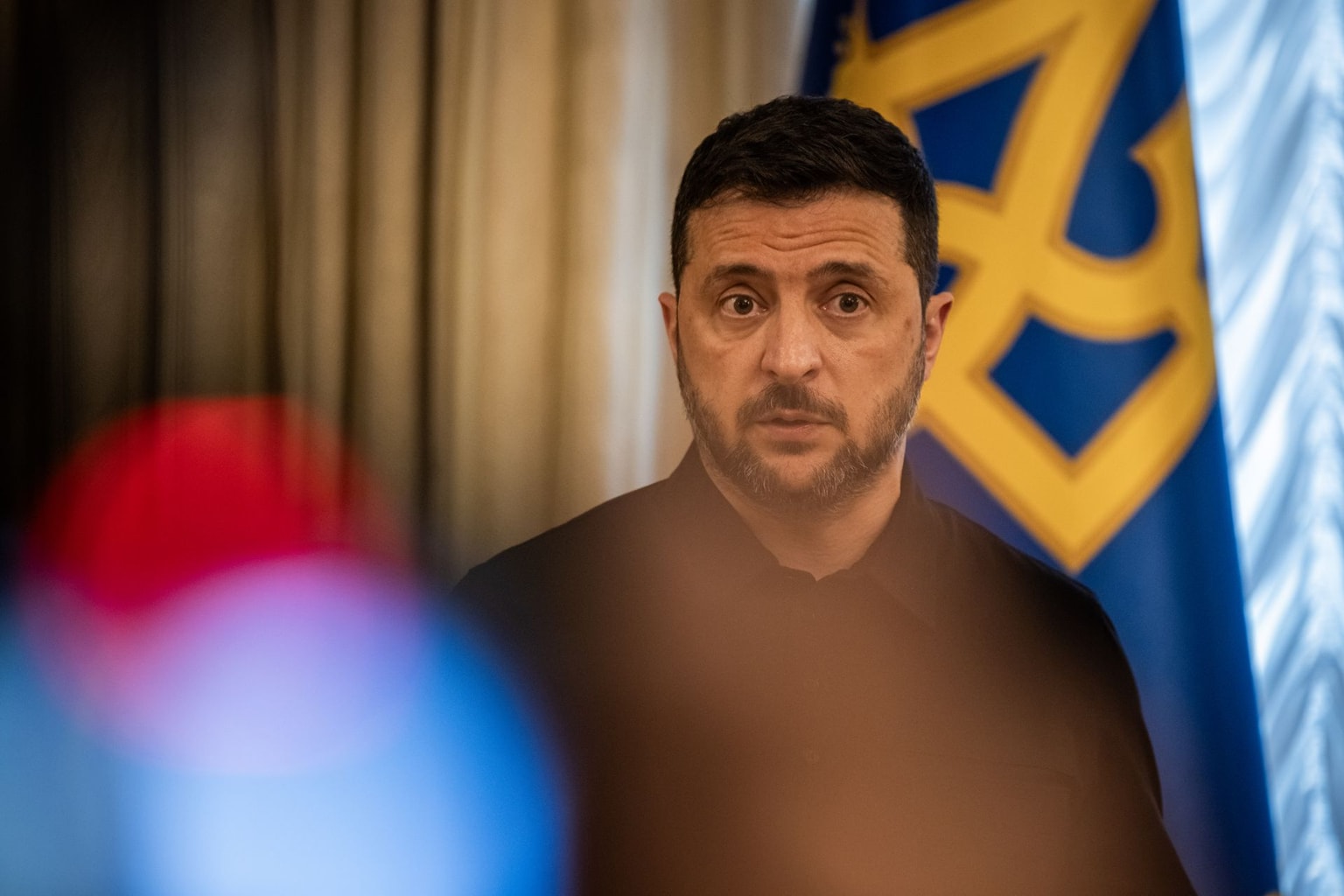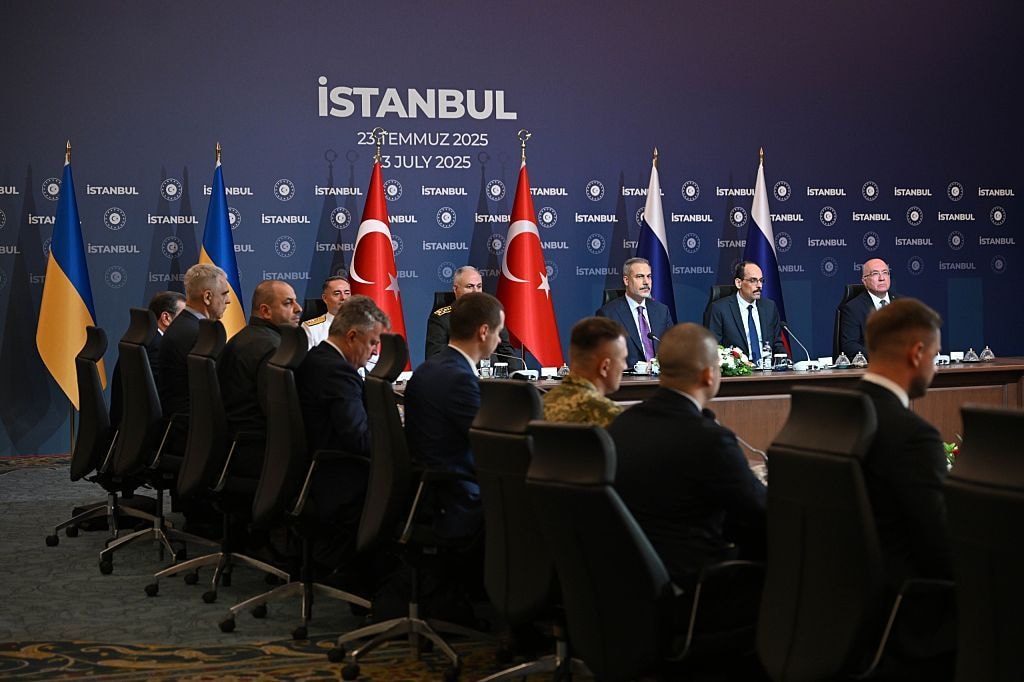Ukraine war latest: 170,000 Russian troops deployed in Pokrovsk sector, Zelensky says

Hi, this is Asami Terajima reporting from Kyiv on day 1,346 of Russia's full-scale invasion of Ukraine.
Today's top story:
About 170,000 Russian troops are deployed in the Pokrovsk sector in eastern Donetsk Oblast to aiming capture the semi-surrounded city, President Volodymyr Zelensky told journalists on Oct. 31.
"All their forces are there," Zelensky told journalists in a briefing, as cited by Ukrainian news agency Ukrinform.
"There are Russians in Pokrovsk. Our guys are destroying them, destroying them little by little — because we also have to protect our personnel."
Zelensky's comment about the importance of protecting troops could signal a potential withdrawal in the near future. Currently, there is just over a 10-kilometer (six miles) gap for Ukrainian troops to bring in troops and supplies into Pokrovsk, according to the Ukrainian open-source battlefield monitoring group DeepState.
Russian troops are intensifying their infiltration in Pokrovsk to encircle Pokrovsk, the Ukrainian military reported on Oct. 29. Russian units that have infiltrated Pokrovsk are trying to advance toward the northwest and north of the city, 7th Rapid Reaction Corps of Ukraine’s Air Assault Forces said.
Zelensky said at a briefing on Oct. 31 that about 170,000 Russian forces are deployed in the Pokrovsk sector.
President Volodymyr Zelensky told journalists on Oct. 27 that Russia outnumbers Ukrainian troops eight-to-one in their offensive to capture Pokrovsk.
Venezuela reportedly requests missiles, radars from Russia amid US tensions
Last updated 20:44 Kyiv time.
Venezuelan dictator Nicolas Maduro is requesting military aid from Russia, the Washington Post (WP) reported on Oct. 31, citing confidential documents reviewed by the outlet.
The request comes amid escalating tensions in the Caribbean Sea as the U.S. military carries out strikes on suspected drug-trafficking vessels and Washington reportedly considers air strikes on Venezuelan military facilities allegedly used for drug smuggling.
Maduro wrote a letter to Russian President Vladimir Putin requesting repairs for radars, military aircraft, and possibly missile supplies, according to U.S. government documents obtained by WP.
Maduro has a close relationship with Moscow, bolstered by their shared animosity toward the West. Venezuela's president has denounced Western sanctions on Russia and backed Moscow's war.
The documents also reportedly show that Venezuelan authorities sought military support and equipment from China and Iran to strengthen the country's defense capabilities.
Pentagon greenlit Tomahawks for Ukraine, Trump made final decision, CNN reports
Last updated 19:39 Kyiv time.
The Pentagon approved sending Tomahawk missiles to Ukraine, giving the final say to U.S. President Donald Trump, CNN reported on Oct. 31.
Kyiv had hoped the missiles would enhance its ability to target Russian energy infrastructure and increase Moscow's economic costs, and in the lead up to President Volodymyr Zelensky and Trump meeting in Washington earlier this month, it had seemed like a possibility.
Ultimately, Zelensky came away from the meeting without them, despite Trump teasing the idea on several occasions.
According to CNN, the missiles are still on the table and the White House has plans in place to send them quickly should Trump give the order.
Read the full story at CNN.
Poland intercepts Russian reconnaissance plane — again
Last updated 17:55 p.m. Kyiv time.
Polish fighter jets were scranbled to intercept a Russian Il-20 reconnaissance aircraft flying over the Baltic Sea, the country's army said on Oct. 31.
"The Russian aircraft again flew without a filed flight plan and with its transponder turned off, posing a potential threat to traffic safety in the region," a stateent on social media read.
"Polish pilots intercepted and identified the foreign aircraft, which was escorted in accordance with NATO procedures."
It's the third such mission launched by Polish forces in a week.
Neptune missiles struck Russian energy infrastructure, oil refineries, Ukraine confirms
Last updated 6:09 p.m. Kyiv time.
Ukraine’s Navy confirmed that its forces used domestically produced Neptune cruise missiles to strike major Russian energy facilities overnight on Oct. 31.
The missiles hit the Oryol Thermal Power Plant (TPP) and the Novobryansk electrical substation in Russia’s Oryol Oblast, the Ukrainian Navy reported. Both facilities supplied power to military-industrial plants in the region, and their destruction "dealt a serious blow to the occupiers’ logistics."
"The Ukrainian military continues to demonstrate that no enemy rear is safe," the Navy added on Telegram.
Originally, Neptune was Ukraine’s ground-launched, domestically produced anti-ship rocket with a maximum range of 300 kilometers which it famously used in April 2022 to sink Russia’s Black Sea flagship, the Moskva.
Ukraine has since produced a number of upgraded versions.
Special Operations Forces destroy Buk-M3 air defense system, Nebo-U radar in Russia's Rostov Oblast
Ukraine's Special Operations Forces (SSO) said on Oct. 31 that it had destroyed a Russian Buk-M3 air defense system and a Nebo-U radar in Russia's Rostov Oblast, which borders Ukraine to the east.
The Buk-M3 air defense system destroyed in the claimed September attack can hit targets up to 80 kilometers, Special Forces said in its Telegram post. It added that a Nebo-U radar can detect fighter jets in a range of up to 400 kilometers.
The SSO claim comes as Ukraine continues to hit military targets and oil refineries deep inside Russia using domestically produced long-range drones, trying to slowly grind down Russia's war machine.
"Both systems posed a major threat to the operations of Ukraine's combat aviation in the frontline zone and hindered Ukrainian deep strike attacks," the SSO said, adding that each complex costs "hundreds of millions of dollars."
Ukraine destroyed 'Oreshnik' missile inside Russian territory, Zelensky says
Last updated 2:25 p.m. Kyiv time.
Ukraine’s security services destroyed a Russian Oreshnik ballistic missile inside Russia during the summer of 2024, President Volodymyr Zelensky said at a press briefing on Oct. 31.
The operation involved Ukraine’s Security Service (SBU), the Defense Intelligence Directorate (HUR), and other branches of the Defense Forces, Zelensky said.
SBU chief Vasyl Maliuk later specified that the missile was destroyed at the Kapustin Yar missile range in Russia’s Astrakhan Oblast — a major site for testing Moscow’s strategic weapons.
Zelensky added that Russia can produce up to six such missiles per year and is reportedly seeking to deploy them in Belarus.
"It has a range of up to 5,000 kilometers and a 700-kilometer dead zone. Our partners in Europe should pay attention to this," Zelensky said in comments reported by Suspilne.
Russia first used the experimental Oreshnik missile during a strike on the Ukrainian city of Dnipro on Nov. 21, which Putin said was in retaliation for Ukraine’s use of U.S. and British long-range missiles against Russian territory.
'You never know where the bullet will come from' — Russian troops carry out torture, executions in own ranks, media investigation finds
Last updated 12:36 p.m. Kyiv time.
Extrajudicial killings within the Russian military are becoming more widespread, according to an investigation published by the Russian independent outlet Verstka.
The practice of "nullifying" (Russian: "obnulenie") — the Russian military's term for executing its soldiers — increasingly involves sending personnel on deadly assualt missions without proper protection, journalists found.
Verstka collected information on over 100 "nullifiers" among Russia's senior officers. Investigators spoke to military personnel and their families, and also studied complaints from the military prosecutor's office.
One example is Colonel Igor Istrati, a commander of Russia's 114th Separate Motorized Rifle Brigade, who allegedly ordered executions and torture of soldiers in his unit. He reportedly sent troops on assualts without weapons or equipment in an effort to "nullify" targeted soldiers.
"You know, what's happening there is that... You never know where the bullet will come from: from your own side or from the Ukrainians," said Dmitry, a member of the brigade.
New missile that pushed Trump to leave nuclear treaty fired by Russia at Ukraine, Reuters reports
Last updated 11:41 a.m. Kyiv time.
A Russian missile whose development pushed U.S. President Donald Trump to withdraw from the Intermediate-Range Nuclear Forces (INF) Treaty back in 2019 has been fired at Ukraine on numerous occasions, Reuters reported on Oct. 31, citing Ukrainian officials.
Russia's 9M729 ground-launched cruise missile, sometimes referred to as the Iskander K to distinguish it from Iskander M ballistic missiles, was recorded flying as far as 1,200 kilometers, according to unnamed Ukrainian officials cited by Reuters.
Signed by then U.S. President Ronald Reagan and Soviet leader Mikhail Gorbachev in 1987 towards the end of the Cold War, the INF Treaty banned all ground-launched missiles with ranges between 500 and 5,500 kilometers, in an effort to reduce the density of potentially nuclear-armed weapons deployed by Russia and NATO in Europe.
Russia initially claimed that that the missile, like the Iskander M, has a range within to treaty's limits, but reports by U.S. officials and analysts in 2017, claimed that the real range was as high as 2,500 kilometers.
The reports of Russia deploying the 9M729 at a longer range vindicate Trump's decision to withdraw from the treaty, which Moscow only left in August 2025.
At least 14 killed, 71 injured in Russian attacks on Ukraine over past day
At least 14 people were killed, and 71 people were injured in Russian attacks against Ukraine over the past day, local authorities reported on Oct. 31.
The Air Force reported on Oct. 31 that Russia had launched 146 Shahed, Gerbera and other types of drones against Ukraine overnight, of which about 90 were Shahed. It said it downed 107 of them, in addition to a ballistic missile.
In eastern Donetsk Oblast, Russian attacks killed eight people and wounded 18 over the past day, regional governor Vadym Filashkin said on Oct. 31.
In northeastern Kharkiv Oblast, regional governor Oleh Syniehubov said on Oct. 31 that Russian attacks wounded two, including a 78-year-old man and a 56-year-old woman, over the past day.
In southeastern Zaporizhzhia Oblast, regional governor Ivan Fedorov said on Oct. 31 that 3 people were killed, and 29 were wounded in Zaporizhzhia and the city's surrounding region over the past day. He reported that Russian forces had struck Zaporizhzhia with nine missiles in this timeframe.
In southern Kherson Oblast, regional governor Oleksandr Prokudin said in the morning on Oct. 31 that a person was killed and seven were wounded, including one child.
In northeastern Sumy Oblast, the regional military administration said on Oct. 31 that 15 people were wounded, including four children.
On top of the casualties, the Ukrainian railway reported on Oct. 31 that its infrastructure had suffered from Russian attacks in Sumy and Kharkiv oblasts in the northeast overnight.
General Staff: Russia has lost 1,141,830 troops in Ukraine since Feb. 24, 2022
ussia has lost around 1,141,830 troops in Ukraine since the beginning of its full-scale invasion on Feb. 24, 2022, the General Staff of Ukraine's Armed Forces reported on Oct. 31.
The number includes 970 casualties that Russian forces suffered over the past day.
According to the report, Russia has also lost 11,310 tanks, 23,519 armored fighting vehicles, 66,111 vehicles and fuel tanks, 34,128 artillery systems, 1,533 multiple launch rocket systems, 1,233 air defense systems, 428 airplanes, 346 helicopters, 76,355 drones, 28 ships and boats, and one submarine.










